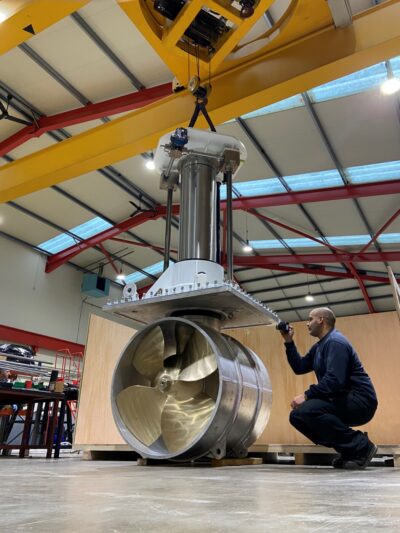NEWS & EVENTS
Use The Force
 Bow thrusters are simple, aren’t they? It’s just a tunnel and a prop and some noise, right?
Bow thrusters are simple, aren’t they? It’s just a tunnel and a prop and some noise, right?
Well yes, often this is the case. Your bow thruster may well consist of a single type propeller, gearbox and a motor that may or may not change size depending on what you have been sold. However, things start getting ‘tricky’ when you start looking at how to really be efficient with the power you have on board, the space available and what the skipper really expects to happen when they lean that joystick over to port. Just ticking a box [Bow Thruster Y/N] is how many builds historically went, a reassuring annoying noise and some white water from upfront confirming that indeed the task has been met. Well, that was old thinking.
Now specialist companies, such as Ocean Marine Systems, spend considerable hours ensuring the product offered really does meet everyone’s needs. Meeting efficiency targets through more powerful, quieter motors and spending considerable time helping a builder assess the overall peak power consumption is a major part that a specialist bow thruster supplier plays.
The recent advances in hydraulics and arguably even more so in electric drives have seen the current generation of thruster options and efficiencies improve dramatically. The OMS range now features permanent magnet (PM) synchronous electric motors, either air or water-cooled, whilst being matched to continuous rated thruster gearboxes. All OMS thrusters can be set for use 24/7 as part of a high-efficiency dynamic positioning (DP) package.
The impact of the thruster on a vessel’s efficiency not only relates to the thruster when operating but also what effect that thruster has on the vessel when it’s not being used, is that large open void and grill really helping our fuel consumption during passage making? Having a thruster that appears only when required means a smooth and efficient hull when not being used. Vertical and swing units also make stern thrusters an option with a hull shape that would otherwise not accept a thruster. A supplier that works with your hull line and geometry is critical.
After your main engine, your thruster is probably your largest single energy consumer, but are you are using it to its full potential? Having a large amount of thrust blasting sideways from your hull is a great way to protect, manoeuvre and control your asset, but could you control that force in an even more helpful way? Adding rotation to a thruster system (azimuth) suddenly allows you to accurately direct power and perform some very graceful, controlled spins whilst ensuring every ounce of energy is directed exactly where you need it. Individual or paired up azimuth thruster can also provide you with a secondary propulsion system, allowing you to leave the dock on just gensets meaning a quieter more peaceful arrival or departure. For the larger classic vessels of this world, having an alternative steerable unit also gives them the ability to switch on and go, without the many hours of start-up that some classic engines need prior to being coxed into turning the main prop!
Your thruster supplier needs to work with you to integrate the system and its power. It’s not a brochure tick box item, use the force wisely (Luke).
